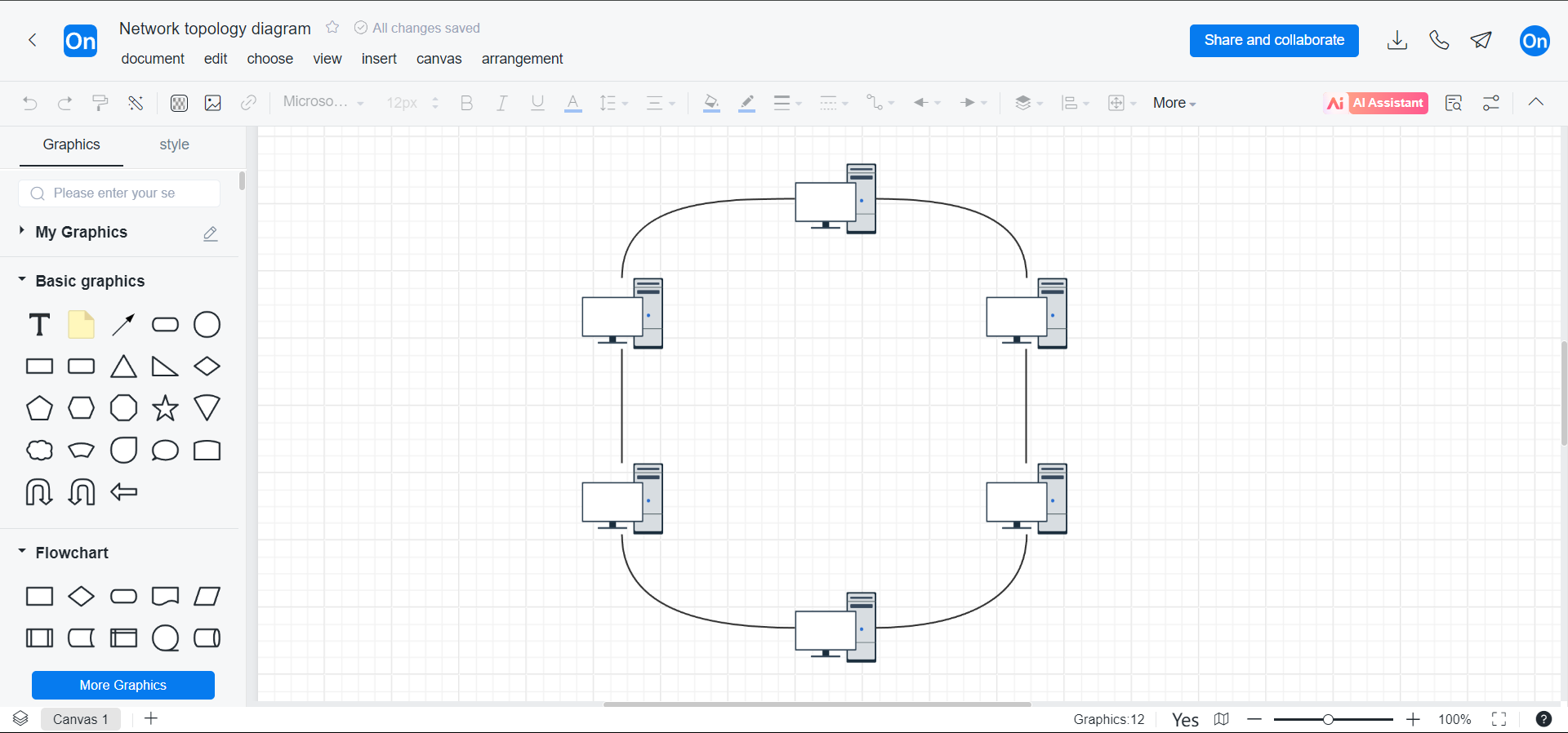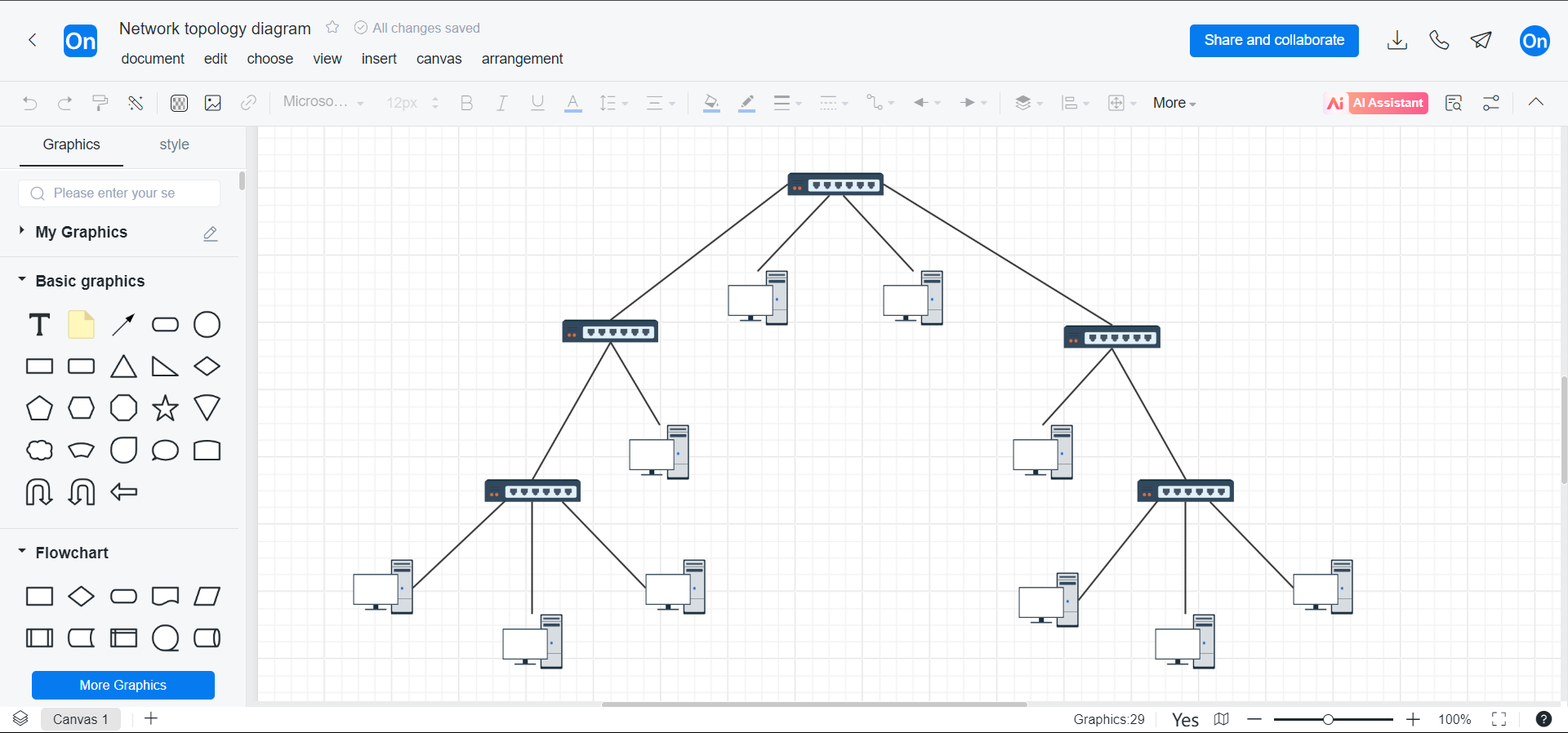In today's information age, network topology plays a vital role. It is not only a visual representation of the network structure, but also an important tool to help us understand and optimize network design. Whether you are an IT novice or a senior network engineer, mastering the production of network topology is very necessary.
So, what is network topology, what are the types of network topology diagrams, and what are the best tools for creating them? This article will guide you through the basics of network topology diagrams, common types, and how to use ProcessOn to efficiently draw network topology diagrams, helping you to be at ease in network design and management.
A network topology diagram is a graphical representation of the network structure. It describes how various devices in the network are interconnected through different connection methods, providing a comprehensive picture of the network layout. Through the topology diagram, we can intuitively see the components of the network and the connection relationships between them, which is extremely helpful in network planning, design, maintenance, and troubleshooting.

There are many types of network topology diagrams, each with its own unique advantages and applicable scenarios. Below are some common types:
Star topology is one of the most common network topologies. In this topology, all devices are connected through a single central node (usually a switch or hub). The central node is responsible for managing network traffic and forwarding data packets, and all communications must pass through it. The advantage of this structure is that if a device fails, it does not affect the communication of other devices. However, if the central node fails, it causes the entire network to fail.

The bus topology is a simple and low-cost network structure. In this topology, all devices are connected through a shared communication cable. Data is transmitted bidirectionally on the bus, and devices communicate by listening to data on the bus. Although the bus topology performs well in small networks, it has poor scalability, and any failure on the bus may disrupt the entire network.

Ring topology connects all devices into a closed loop. Data flows in one direction within the ring, and each device receives and forwards data. The advantage of ring topology is faster data transmission since data only needs to pass through each device once. However, if a device in the ring fails, the entire network is interrupted. To improve reliability, a dual ring structure is often used for backup.

The tree topology combines the advantages of the star and bus topologies, forming a hierarchical network structure. In tree topology, multiple star networks are connected by a trunk bus. It is suitable for large-scale networks because it supports expansion and hierarchical management. However, it also has the risk of a single point of failure; failure of the trunk bus may affect the normal operation of the entire network.

Mesh topology is a highly reliable network structure. In a mesh topology, each device is directly connected to other devices. This design provides extremely high fault tolerance because data can be transmitted through multiple paths, ensuring high availability of the network. Mesh topology is very suitable for scenarios requiring high reliability but is more expensive and complex to manage and maintain.

When creating a network topology diagram, several tools can help you complete the work easily. Below, we recommend using ProcessOn for drawing network topology diagrams.
In ProcessOn, many users share professional network topology diagrams for free, which can be directly cloned and modified to fit your needs. You can find many references to inspire your designs, making the drawing process less daunting.
1. Clarify Your Purpose: Before starting, clearly define your goal. Different purposes require different diagrams. For example, showing the overall network structure may require an abstract view, while troubleshooting may require detailed device and connection information. In ProcessOn, you can use AI to help spark inspiration.
2. Use Standard Symbols: Using standard symbols improves the professionalism and readability of your diagrams. For example, use different icons to represent switches, routers, servers, and other devices, ensuring each symbol and connection line is clearly defined. ProcessOn provides many built-in standard icons, covering Cisco, Huawei Cloud, Tencent Cloud, Alibaba Cloud, and more.

3. Keep it Simple: The network topology diagram should be as concise and clear as possible, avoiding over-complication. Displaying the network diagram in layers or showing different parts in multiple diagrams can improve clarity. ProcessOn supports a one-click beautification function to instantly clean up your drawings and clarify line relationships.
4. Update Icons: The network environment constantly changes, so the topology diagram needs regular updates. Ensure the diagram reflects the current network structure for easier maintenance and management. ProcessOn is accessible on iOS, Android, PC, Mac, and other devices, allowing for updates anytime, anywhere.
5. Mark Key Equipment: Marking key devices and connections helps quickly identify issues. For example, you can use different color markers to highlight key switches, routers, or network interfaces. ProcessOn offers 26 pre-made themes, allowing you to change colors and font sizes at will, making key elements stand out.
Alibaba Cloud network topology diagram
As an essential tool for network design and management, network topology helps us better understand and optimize network structures. By mastering the basics of network topology, familiarizing yourself with different topology types, and choosing the right tools, you can efficiently create and maintain clear network topology diagrams.If you want to learn how to draw a network topology diagram, you can go to How to draw a network topology diagram? A complete guide to learn it in 5 minutes! to check it out.